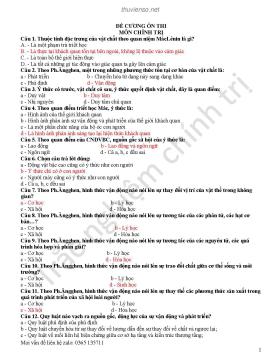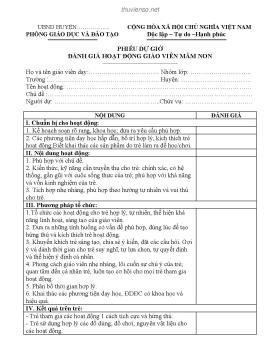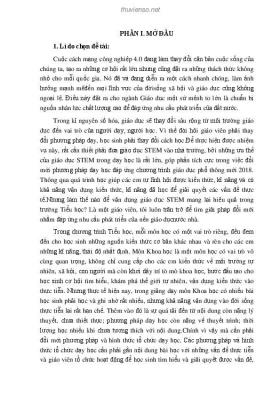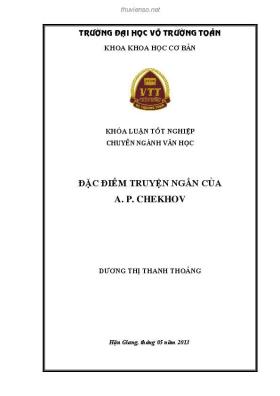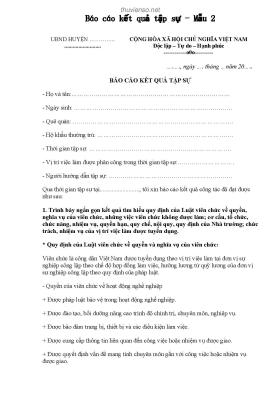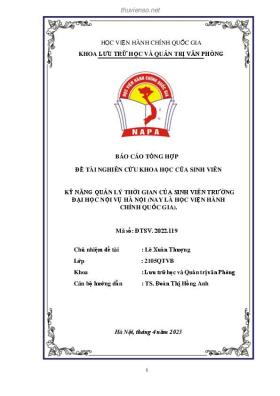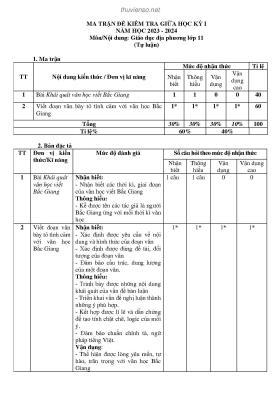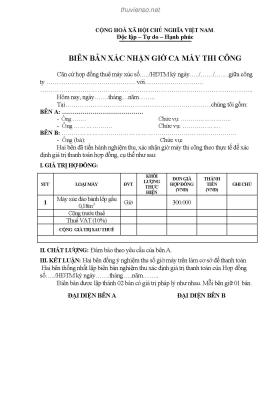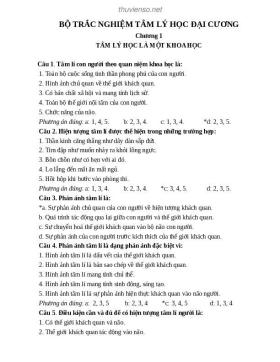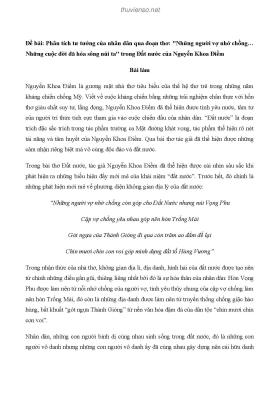
Bài giảng Phát triển ứng dụng Web – Web Programming: Chương 4 - ThS. Lương Trần Hy Hiến
Số trang: 102
Loại file: pdf
Dung lượng: 4.28 MB
Lượt xem: 15
Lượt tải: 0
Xem trước 10 trang đầu tiên của tài liệu này:
Thông tin tài liệu:
Dưới đây là bài giảng Phát triển ứng dụng Web – Web Programming: Chương 4 - Introduction to HTML5 do ThS. Lương Trần Hy Hiến thực hiện. Mời các bạn tham khảo bài giảng để hiểu rõ hơn về HTML5 Structure; HTML5 Audio/Video; HTML5 Form; HTML5 Canvas.
Nội dung trích xuất từ tài liệu:
Bài giảng Phát triển ứng dụng Web – Web Programming: Chương 4 - ThS. Lương Trần Hy Hiến HTML5/CSS3 Course Introduction to HTML5 Presenter: Msc. Luong Tran Hy Hien, FIT of HCMUP. 1 HTML5 = HTML + CSS + JS API 2 Contents • HTML5 Structure • HTML5 Audio/Video • HTML5 Form • HTML5 Canvas 3 New and Updated HTML5 Elements HTML5 introduces 28 new elements: , , , , ,, , , , , , , , ,, , , , , ,, , , ,, , and 4 HTML5 Structure 5 Structure 6 Structure 7 Structure HTML5 offers new semantic elements to define different parts of a web page: • • • • • • • • • • • • 8 • • The section element represents a generic section of a document or application. A section, in this context, is a thematic grouping of content, typically with a heading 9 • A header element is intended to usually contain the section's heading (an h1–h6 element or an hgroup element), but this is not required. The header element can also be used to wrap a section's table of contents, a search form, or any relevant logos 10 • The hgroup element represents the heading of a section. The element is used to group a set of h1–h6 elements when the heading has multiple levels, such as subheadings, alternative titles, or taglines 11 • The footer element represents a footer for its nearest ancestor sectioning content or sectioning root element. A footer typically contains information about its section such as who wrote it, links to related documents, copyright data, and the like 12 • The article element represents a self-contained composition in a document, page, application, or site and that is, in principle, independently distributable or reusable, e.g. in syndication. This could be a forum post, a magazine or newspaper article, a blog entry, a user- submitted comment, an interactive widget or gadget, or any other independent item of content.. 13 • The nav element represents a section of a page that links to other pages or to parts within the page: a section with navigation links 14 Block semantic element • • 15 • The aside element represents a section of a page that consists of content that is tangentially related to the content around the aside element, and which could be considered separate from that content. Such sections are often represented as sidebars in printed typography. 16 • Specifies self-contained content, like illustrations, diagrams, photos, code listings, etc 17 Inline semantic element • • • • 18 • Defines marked/highlighted text 19 • Defines a date/time 20
Nội dung trích xuất từ tài liệu:
Bài giảng Phát triển ứng dụng Web – Web Programming: Chương 4 - ThS. Lương Trần Hy Hiến HTML5/CSS3 Course Introduction to HTML5 Presenter: Msc. Luong Tran Hy Hien, FIT of HCMUP. 1 HTML5 = HTML + CSS + JS API 2 Contents • HTML5 Structure • HTML5 Audio/Video • HTML5 Form • HTML5 Canvas 3 New and Updated HTML5 Elements HTML5 introduces 28 new elements: , , , , ,, , , , , , , , ,, , , , , ,, , , ,, , and 4 HTML5 Structure 5 Structure 6 Structure 7 Structure HTML5 offers new semantic elements to define different parts of a web page: • • • • • • • • • • • • 8 • • The section element represents a generic section of a document or application. A section, in this context, is a thematic grouping of content, typically with a heading 9 • A header element is intended to usually contain the section's heading (an h1–h6 element or an hgroup element), but this is not required. The header element can also be used to wrap a section's table of contents, a search form, or any relevant logos 10 • The hgroup element represents the heading of a section. The element is used to group a set of h1–h6 elements when the heading has multiple levels, such as subheadings, alternative titles, or taglines 11 • The footer element represents a footer for its nearest ancestor sectioning content or sectioning root element. A footer typically contains information about its section such as who wrote it, links to related documents, copyright data, and the like 12 • The article element represents a self-contained composition in a document, page, application, or site and that is, in principle, independently distributable or reusable, e.g. in syndication. This could be a forum post, a magazine or newspaper article, a blog entry, a user- submitted comment, an interactive widget or gadget, or any other independent item of content.. 13 • The nav element represents a section of a page that links to other pages or to parts within the page: a section with navigation links 14 Block semantic element • • 15 • The aside element represents a section of a page that consists of content that is tangentially related to the content around the aside element, and which could be considered separate from that content. Such sections are often represented as sidebars in printed typography. 16 • Specifies self-contained content, like illustrations, diagrams, photos, code listings, etc 17 Inline semantic element • • • • 18 • Defines marked/highlighted text 19 • Defines a date/time 20
Tìm kiếm theo từ khóa liên quan:
Phát triển ứng dụng Web Bài giảng Phát triển ứng dụng Web Web Programming HTML5 Structure HTML5 Audio/Video HTML5 FormTài liệu liên quan:
-
Giáo trình Phát triển ứng dụng web: Phần 2 - Lê Đình Thanh, Nguyễn Việt Anh
126 trang 83 0 0 -
Lecture Web technologies and programming – Lecture 1: Introduction to web engineering
48 trang 79 0 0 -
Lecture Web technologies and programming – Lecture 12: Introduction to Cascading Style-sheets (CSS)
52 trang 70 0 0 -
Phát triển thuật toán sinh code cho ứng dụng web chuẩn đoán bệnh thủy sản với ATL
10 trang 68 0 0 -
Bài giảng Phát triển ứng dụng web 1: HTML From - ĐH Sài Gòn
34 trang 65 0 0 -
Bài giảng Phát triển ứng dụng web: Chương 0 - Lê Đình Thanh
10 trang 45 0 0 -
Bài giảng Phát triển ứng dụng web: Chương 7 - Lê Đình Thanh
41 trang 45 0 0 -
Bài giảng Phát triển ứng dụng Web: Bài 6 - Nguyễn Hữu Thể
24 trang 42 0 0 -
Bài giảng Phát triển ứng dụng web: Chương 1 - Lê Đình Thanh
47 trang 42 0 0 -
Xây dựng và thử nghiệm công cụ CODEGER-UWE phát triển ứng dụng Web hướng mô hình
5 trang 42 0 0


